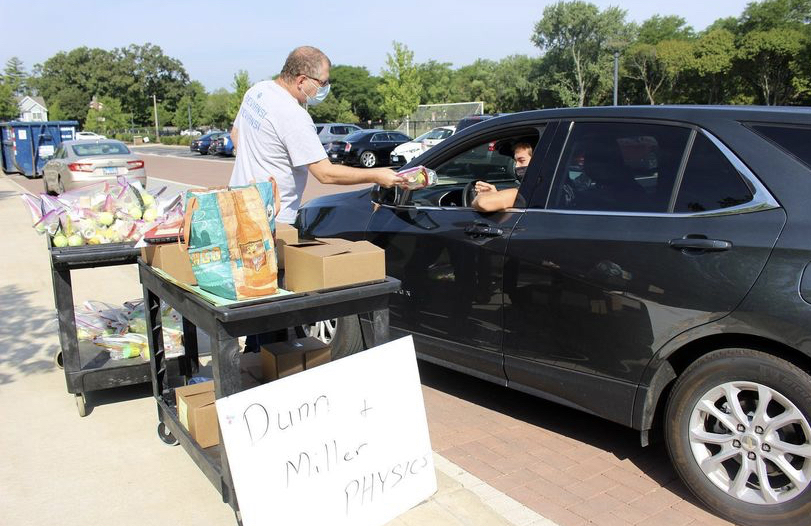Teachers zoom to adapt to remote learning
Despite difficulties at beginning of quarantine, faculty more comfortable and prepared during the 2020-2021
Physics teacher John Miller passes out lab kits to students in order for them to be able to carry out various science experiments remotely
Last year, COVID and quarantine served as the butt of a joke, a theoretical threat far from home. However, on March 12 during ninth period, the school shut down, which would come to last until the end of the school year, thrusting teachers into an unknown and unprecedented territory—teaching students remotely.
During the three day span between the school shutdown and the first days of Zoom school, teachers engaged in extensive professional development, including getting to know Zoom, a foreign concept at the time, and creating a robust Canvas page that would be simple enough for students to navigate.
According to cooking teacher Dawn Sullivan, teaching during the beginning of quarantine was stressful and anxiety-provoking.
Science teacher Micah Bank and music teacher David Ladd, described the experience as essentially being a first year teacher again; they felt disoriented and doubtful of their teaching abilities.
“Nobody knew how to do remote teaching. It was especially difficult for music because music is an ensemble based experience…A lot of the course goals had to change,” said Ladd.
“We were just basically rookies again,” said Bank, “We want to deliver clear, effective lessons, but it just didn’t happen.”
Still, during the beginning of the shutdown, teachers were under the impression that it would only last for a couple of weeks and would be almost like an extension of Spring Break.
“I thought maybe we would have like three weeks or so remote. You would deal with it, and then it would be back to normal,” said Spanish teacher Shawn Mitchum.
But, then, weeks turned to months, months turned into the entirety of the 4th quarter, and the year ended with students and teachers still being entirely remote.
Teachers began remote learning with a lot of “call-and-response,” as English teacher Sarah Gompers put it. They would post assignments on Canvas and students would be expected to turn them in by a certain time. Classes would consist of activities like videos, readings, and Canvas discussion boards. Many teachers became reliant on platforms like Edpuzzle, Pear Deck, and NearPod.
By April, teachers recognized that they needed to implement more Zoom for their classes in order to have some human interaction in a time of severe disconnect and isolation. But, there was a lot of trial-and-error with Zoom—trying to see what would stick, what would actually educate students, and what wouldn’t totally bore them.
Though the teaching environment still wasn’t as effective as being in-person, teachers put their best foot forward.
“It was hard, but I did the best I could and our students were very appreciative of what we were able to do,” said Ladd.
Fortunately, there was one bright spot for teachers during this time
“I knew the kids really well before we went on break,” said Gompers, “I was definitely able to cash out on those relationships…They got us through to the end of the year.”
Following a summer with some sun and professional development, teachers returned to school feeling more prepared to handle the difficulty of remote learning.
“With some student feedback and some time to collaborate with other teachers within and outside of my department, it’s been helpful to get a more fluid course for an online setting,” said Mitchum
In fact, Bank took his preparation a step further and essentially got to test out a more developed remote-style curriculum through teaching physics summer school.
“I had the mindset of doing summer school to help me out this fall, and it did tremendously,” said Bank, “I wasn’t up every night in the fall, developing lessons; I did it in the summer.”
One aspect that many teachers added in the fall, mostly science and arts teachers, was some type of kit that students could pick up at school and use at their homes.
For her cooking class, Sullivan described how making various ingredients kits for remote students to carry out labs at home was a lot of preparation and coordination.
“It’s been a really successful program…When we were fully remote at the beginning of the year and we had the ingredient kits and students were making products at home, it was running phenomenally,” said Sullivan.
Still, remote learning this year has brought some of the same difficulties as last year as well as some new challenges including developing relationships with students strictly over Zoom and maintaining the engagement of students.
“It’s been challenging to connect with them and to encourage them to continue on and to stay a part of the ensemble,” said Ladd.
Gompers explained how remote learning has forced her to become more direct with her students unlike in a normal classroom environment.
In a classroom, “You’re standing right there, so kids will raise their hands and seek you out,” said Gompers, “It’s very easy for them to ignore you on a video call or leave the call.”
Mitchum, very aware of the effect of being on Zoom for long periods of time, has designed his lesson plans accordingly.
“I understand that it’s hard to Zoom all-day and then be expected to continue working,” said Mitchum, “I’ve been pretty intentional about trying to cut the Zoom a little shorter and giving kids independent work time at the end.”
Although the experience is not yet over, this pandemic has continuously offered lessons and teachings in flexibility, humility, and empathy.
“I think so often kids and teachers, especially at New Trier, hold themselves to such high standards,” said Gompers, “It’s okay to try something and have it not perfect; you can always come back again tomorrow.”
“As a teacher, a lot of the times we talk about flexibility and the importance of that, and [remote learning] was just a true example of that,” said Sullivan.
Most of all, the pandemic has taught individuals to value the normalcy and the simple things of their day-to-day lives prior to the pandemic, no matter how dull or excruciating they may have been.
“It’s made me appreciate that much more the teaching when we’re in person and being able to interact with you guys, so I think all of us teachers miss that a ton,” said Bank.









































